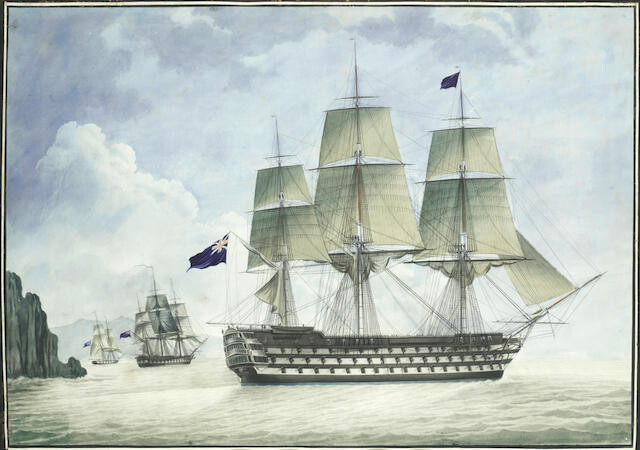Nicholas S. Cammillieri, (Maltese, fl. early/mid 19th Century)
H.M.S. Britannia
H.M.S. Britannia
signed and dated 'Cammillieri 1830' (lower right)
watercolour and black ink
51.5 x 71.5cm (20 1/4 x 28 1/8in).
Designed by Sir William Rule in 1812 and laid down in Plymouth dockyard in December 1813 although not launched until 1820, H.M.S. Britannia ? 120 guns ? was one of the biggest first rates of her day. Finally completed late in 1822, she was a majestic three-decker of 2,616 tons and carried a crew of 594 officers and men, 66 boys and 160 marines. First commissioned in January 1823, she remained in Plymouth for several years as one of the harbour's guardships and then did some short spells of service in the Mediterranean before becoming flagship at Portsmouth in 1836. After further commissions in the Mediterranean, she returned to Portsmouth in 1850 to become Guardship-of-the-Ordinary and remained there until 1854 when, following the outbreak of the Crimean War, she was sent to the Black Sea as flagship to Vice-Admiral Dundas. Action there included leading the Anglo-French fleet in to bombard Sebastopol on 17th October 1854 but, when peace was concluded, she came home to Portsmouth where she was laid up until recommissioned on 1st January 1859 as the first training ship for naval cadets. Her original moorings in Haslar Creek (Portsmouth) and then Portland proving unsuitable, she was eventually moved to Dartmouth in 1863 where she lay until broken up in 1869, her name by then synonymous with the Royal Navy's principal officer training establishment.
Given the date of 1830, this work was almost certainly completed whilst H.M.S. Britannia was on tour in the Mediterranean from 1830-31. This would explain how Cammillieri, the Maltese artist whom also worked in Italy, would have come into contact with the ship.
View it on
Estimate
Time, Location
Auction House
H.M.S. Britannia
H.M.S. Britannia
signed and dated 'Cammillieri 1830' (lower right)
watercolour and black ink
51.5 x 71.5cm (20 1/4 x 28 1/8in).
Designed by Sir William Rule in 1812 and laid down in Plymouth dockyard in December 1813 although not launched until 1820, H.M.S. Britannia ? 120 guns ? was one of the biggest first rates of her day. Finally completed late in 1822, she was a majestic three-decker of 2,616 tons and carried a crew of 594 officers and men, 66 boys and 160 marines. First commissioned in January 1823, she remained in Plymouth for several years as one of the harbour's guardships and then did some short spells of service in the Mediterranean before becoming flagship at Portsmouth in 1836. After further commissions in the Mediterranean, she returned to Portsmouth in 1850 to become Guardship-of-the-Ordinary and remained there until 1854 when, following the outbreak of the Crimean War, she was sent to the Black Sea as flagship to Vice-Admiral Dundas. Action there included leading the Anglo-French fleet in to bombard Sebastopol on 17th October 1854 but, when peace was concluded, she came home to Portsmouth where she was laid up until recommissioned on 1st January 1859 as the first training ship for naval cadets. Her original moorings in Haslar Creek (Portsmouth) and then Portland proving unsuitable, she was eventually moved to Dartmouth in 1863 where she lay until broken up in 1869, her name by then synonymous with the Royal Navy's principal officer training establishment.
Given the date of 1830, this work was almost certainly completed whilst H.M.S. Britannia was on tour in the Mediterranean from 1830-31. This would explain how Cammillieri, the Maltese artist whom also worked in Italy, would have come into contact with the ship.



